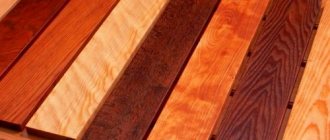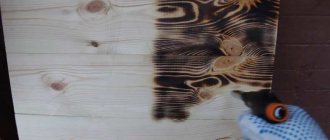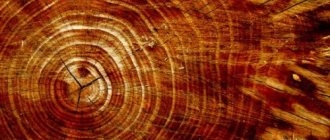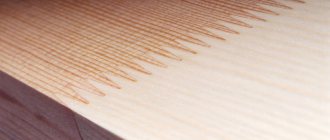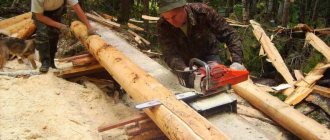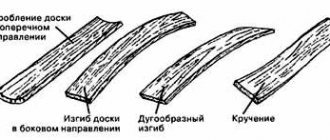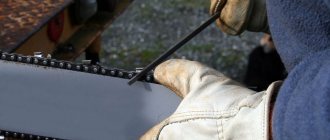Curvilinear furniture frame structures are difficult to produce, and large curves cut from straight sections of wood will require complex manufacturing techniques to avoid the weakness of short fiber and large, uneconomic waste. However, using dry or wet bending techniques, complex curved shapes can be produced quite economically, and since the fibers will run along the bend rather than across it, the finished product will be stronger. Dry bending involves first dividing the wood into thin sections, but thicker pieces can be bent by soaking or steaming.
Michael Toneti's bent café chairs and rocking chairs are classic examples of bent furniture made by steaming, and in the thirties of the 20th century, furniture made from laminated materials became an element of high fashion, after the invention of industrial methods for producing various grades of plywood. Both steam bending and layer bending can be accomplished in the home workshop, and both methods continue to be used in the antique furniture industry and by skilled craftsmen and designers.
Steamed wood can bend with a relatively large bending angle. The steam softens the wood fibers enough to bend them and mold them into the desired shape. It may require significant bending force, but it is quite achievable in a home workshop using basic equipment. You will need to make a template, a clamping clamp and a steam chamber. Wood bending is not a precise procedure. There are many options, and often trial and error is the only possible way to obtain the desired result.
Wood bending
Thin wooden pieces do not require preliminary preparation. The minimum radius to which it can be bent will depend on the thickness and natural properties of the wood species. Thin wood, in the absence of deformation limiters (and in the form of, for example, a template), when bent freely, will take the shape of a ring if the ends of the workpiece are brought together. To obtain a greater bending steepness, the wood must be steamed and “kept” fixed on the template so that, having taken the desired shape, it is stabilized in this position due to internal residual deformation. When thick wood is bent, it is necessary to limit the stretching of the outer layers to prevent them from peeling off or breaking. The method described here is intended for bending relatively thick pieces of wood.
Wood preparation
For bending, choose straight-grained wood without knots or cracks. Any defect or flaw is potentially a weak point, so certain failures are possible. There are dozens of types of wood that can be successfully steam-bent, and many of them are hardwoods. In the table below you can find a short list of suitable types of material for bending. You can bend well-dried wood, but freshly cut wood is easier to process. Atmospherically seasoned wood bends better than chamber- or oven-dried wood. If the wood is too dry and difficult to work with, you can soak it for several hours before steaming.
Depending on the type of workpiece, you can cut it to size in advance or do it with a saw, plow or stapler after bending. The latter method is often used in the production of bent furniture such as Windsor chairs and armchairs. Wood with a flat, smooth surface finish is less likely to delaminate and will make the final finish of the entire piece easier. Green wood shrinks more than seasoned wood, and when turned on a lathe before bending, it tends to take on an oval cross-section when drying. Regardless of the shape and size, make the length of the workpiece approximately 100 mm longer than the length of the finished product. Then, in case of delamination or splitting of the ends after bending, it will be possible to trim off the damaged areas.
To calculate the length, make a drawing of the bend shape on a scale of 1:1. Measure the outside of the curved piece to get the correct length. This will prevent unnecessary stretching of the external fibers, which could lead to cracking under the influence of internal stresses. The softened inner fibers will be able to shrink enough to take the shape of a smaller inner bend.
Delamination method
First you need to make a piece of wood that will be bent. The boards should be slightly longer than the length of the finished part. This is because bending will shorten the slats. Before you start cutting, you should draw a diagonal line with a pencil. This needs to be done across the underside of the board. This will allow you to maintain the sequence of the lamellas after they are moved. The boards are cut with a straight-layer edge, in no case with the right side. So, they can be added together with the least change. A layer of cork is applied to the mold. This will help avoid any unevenness in the shape of the saw, allowing for a cleaner bend. In addition, the cork will keep the delamination in shape. Now glue is applied to the top side of one of the wooden slats. The glue is applied to the slats with a roller. It is best to use urea-formaldehyde glue, consisting of 2 parts. It has a high level of adhesion but takes a long time to dry. You can also use epoxy resin, but this composition is very expensive, and not everyone can afford it. Standard wood glue cannot be used in this case. It dries quickly, but is very soft, which is not welcome in this situation. The bent wood blank should be placed in the mold as quickly as possible. So, another lamella is placed on top of the lamella coated with glue. The process is repeated until the bent piece reaches the desired thickness. The boards are fastened together. After the glue has completely dried, you should shorten it to the desired length.
Making a clamp clamp
The key to making a tight bend is to use a flexible clamp. Make a clamp from mild steel, 2mm thick and at least as wide as the workpiece you bend. This will work for almost any job you might need to do. To avoid possible contamination of the surface of the part as a result of reactions between the chemical elements of wood, metal and the environment, make the clamp from stainless steel or galvanized steel or use a polyethylene gasket.
Install end stops or stops on the clamp to secure the ends of the workpiece, thereby preventing the fibers on the outside of the curved part from stretching and delaminating. These stops must be strong enough to withstand significant pressure on them, and be of sufficient size so that the end of the workpiece can rest against the stop with its entire surface. You can make them from thick angle metal or from solid wood, which is usually easier to do.
To equip the clamp with reliable end stops, install wooden blocks approximately 225 mm long at the ends of the metal strip. Along the center lines of each block, drill two holes with a diameter of 9 mm at a distance of about 150 mm from each other. Mark and drill the clamp strip for the end stop mounting bolts. The distance between the stops must be equal to the length of the workpiece, including the allowance. To ensure that the clamp has a lever action that is convenient for operation, attach sufficiently strong wooden blocks to the ends of the strip on its back side using long bolts for fastening the stops.
Making a template
Steamed wood is bent into a pattern that defines the shape of the bend and provides support for the fibers of the interior of the curved piece. The template must be very strong and have a width that is at least equal to the width of the part being bent. It must provide certain possibilities for fixing the workpiece on it using clamps or other clamps.
Communities › DIY › Blog › Do-it-yourself steam generator for smokehouse
Good morning everyone, I continue to develop the topic of smoking, I wrote about the smoke generator and smokehouse in a previous entry: www.drive2.ru/c/575295271051722779/
Today the topic will be about the steam generator.
The steam generator itself is a stainless steel pipe, 120 mm in diameter, wall thickness 0.5 mm, pipe length 0.5 mm.
For it we take 2 plugs with a condensate drain, one external and one internal. We also take a small heating element that we can find.
In the inner plug we make 2 holes according to the diameter of the heating element contacts, in the end you should get something like this:
Next, the argon welding process begins, we weld the seam of the outlet itself, and also insert the plug into the pipe until it stops and weld the seam.
We put on a 3/4 faucet and a heating element and get this design:
Inside it looks like this:
We screw a flexible hose onto the top cover, I installed one made of stainless steel, and connect the whole thing to the smokehouse.
If you smoke in winter, don’t forget to insulate it, I have a steam generator with a 1.5 kW heating element, it boils within 10 minutes.
And not a big video:
How to choose the best wood for bending:
- The wood must be damp before starting the steaming process. It is raw wood that has increased heat transfer. However, some wood already has a high moisture content, while other wood requires pre-impregnation.
- Hardwoods are great for steaming and are more flexible than softwoods.
- Experts note that wood with grain is more susceptible to cracking and bending damage than wood made from straight fibers. Therefore, careful selection of raw materials for bending is necessary.
- The standard recommended for bending is freshly harvested wood, which has a high initial moisture content and is more flexible.
When tested for bending strength, experts concluded that the best materials for bending were white oak and red oak, while soft maple and poplar were rated as the least suitable materials for bending.
Do-it-yourself steam generator: how to avoid mistakes when assembling yourself
It would seem that steam could be simpler. However, not everyone notices how much we need it. And we’re not just talking about a steam room or a sauna. Steam is an excellent cleanser and disinfectant; it penetrates into the thinnest crevices, is absorbed into the depths of pillows and fabrics, helps iron laundry, and cleans fabrics and mechanisms under pressure. Sometimes it becomes necessary to assemble a steam generator with your own hands. A homemade device can work great when cleaning such quickly dirty devices as an air conditioner filter or, for example, a range hood. Today, in our HouseChief editorial review, we’ll tell you what a steam generator is, where it can be used, and what elements it consists of. Our review also contains simple instructions for assembling the unit with your own hands, as well as an analysis of possible mistakes that beginners may make.
Steaming and bending video
We present to your attention a video about the technological process of bending wood:
Good luck and success! Until we meet again, Andrey Noak was with you!
—Categories
- Textiles. Various ideas for working with materials (868)
- Rag rug or what can be made from old things (275)
- Sewing (175)
- Teddy bears (120)
- Leather (97)
- Clothing designers, fashion (57)
- Fabric flowers (48)
- Batik (33)
- Indian patchwork (11)
- Soutache (7)
- Knitting (854)
- Spokes (502)
- Hook (244)
- On the fork (9)
- On fingers (7)
- Furniture and everything related to wood (518)
- Wood carving. (96)
- DIY furniture (65)
- Wood painting (38)
- Birch bark (31)
- Sawing (30)
- Burnout (13)
- Leaf products (12)
- Furniture of the 21st century. (12)
- Screen (12)
- Products made from matches (7)
- Art Nouveau. Furniture and craftsmen (5)
- Art Deco. Furniture and craftsmen (1)
- Home renovation and design (517)
- Interior detail (148)
- Interior (123)
- Mosaic (93)
- Interior painting or frescoes (42)
- Stained glass (39)
- Cleaning and means for it. (36)
- Everything from garbage (16)
- Cooking (450)
- Baking (173)
- All meat (91)
- Blanks (41)
- Drinks (18)
- Korean dishes (13)
- Soups (12)
- Salads (10)
- Milk and dairy products (10)
- Fish (5)
- Sauces (5)
- Embroidery (434)
- Beads (80)
- ribbon embroidery (41)
- Cross stitch (24)
- Satin embroidery (10)
- All made of paper (291)
- Papier mache (60)
- Cardboard (36)
- Corrugated cardboard (7)
- Arte Francese (4)
- Paper mosaic (4)
- Weaving (227)
- Macrame (36)
- Wire (24)
- Wicker furniture (8)
- Notebook (217)
- Painting (186)
- Modeling (177)
- Plaster (78)
- Cold porcelain (20)
- Salt dough (7)
- Art history. Cultural studies (168)
- Philosophy Stars (3)
- Art (157)
- Watercolor (32)
- Health. (150)
- Felt (140)
- Cottage.Garden.Vegetable garden (100)
- Stories from life. Life in France (46)
- Plastic and everything made from it (43)
- Introduction to Drawing (42)
- Eggshell carving and embroidery (30)
- Sculpture (30)
- Metal. Working with it (18)
- Candles (16)
- Glass.Working with it (13)
- Bone (8)
-I'm a photographer
Types of steam generators and their use in the household
Steam generators are most often used for defrosting pipes, arranging baths, saunas and steam rooms. A simple steam converter will cost several times less than building a full-fledged furnace with stones. In order to start using the device, you just need to plug it into the network. Steam converters are used to clean complex mesh or porous equipment and help effectively warm car engines in winter.
If not so long ago it was possible to find powerful steam generators for solid fuel generators running on wood, for example, Perevalov’s steam generator, today most craftsmen prefer models powered by electricity. After all, there is nothing easier than simply connecting the device to an outlet. And finding an old kettle or steamer for a person who has set himself the goal of assembling the device with his own hands is not difficult.
This is also a steam cleaner, but you can only work with it if you need a sender for clothes. It is not suitable for serious work
Based on power, it is customary to divide devices into industrial and household. The former require connection to special networks with a power of 380 V. And household ones, as one would expect, operate from a 220 V electrical outlet. Such a steam oven can also heat water in different ways. Let's consider the main types of such systems:
How to make a patent for stained glass. Circular patent
—Search by diary
—Subscription by e-mail
—Interests
— Regular readers
—Communities
—Broadcasts
-Statistics
Monday, February 25, 2013 02:19 + to quote book
I’ve had a mirror from a chest of drawers for a long time, it’s beautiful with a frame, but I need a rail around it, the old one fell off in parts, and I wanted to change the shape of the mirror. I was scouring the Internet and this is what I found on this topic. https://stroju-sam.ru/kak-sognut-derevyannuyu-rejku-ili-faneru-v-domashnix-usloviyax I easily bend thin slats over the flame of an alcohol lamp or candle. At the same time, I moisten the place that needs to be bent with water, then hold it over flame and slowly bend it. It is important here not to overdo it so as not to break it. You need to bend it smoothly without sudden movements. And in order to bend a thicker piece, I soak it in hot water for about half an hour, then bend it on a mandrel or log prepared for this. I tie the ends and leave it to dry. And I soak the plywood in cold water; in hot water it will delaminate. If I need to bend several parts of the same curve, I make a very simple device. It consists of a series of nails driven parallel into a wooden surface with a corresponding bend, and I simply bend the strip along this contour and leave it to dry. Then I simply remove it. https://www.reaa.ru/cgi-bin/yabb/YaBB.pl?num=1196361852 Steam the wood in hot water and bend it on the mandrel as needed. There is no hot water - you can steam in horse manure; this is how nomadic peoples made frames for yurts. I saw a photo from an exhibition of furniture makers in Germany. there, three 150x150 blocks were braided into a braid, then it turned out that the block was soaked in ammonia - they say it becomes like rubber. after drying - again like wood. When the lath bends, the outer layers stretch, and the inner ones compress. Wood doesn't stretch well. And it doesn't shrink at all. Therefore, when bending, internal stress increases, finds weakness at one point, and the wood crumples at this point. The block breaks in one place. The situation can be improved a little if you press not on the end of the bar when bending, but smoothly along its entire length. In production there is a method where they are rolled with a roller, and the roller acts exactly at the bend. There is no such cantilever load as at the end of the rail. And the rail is deformed only at the bend. A steel strip is placed under the roller, which can additionally be nailed with the initial end to the rail, and the other end is better so that it slides with force when bending, i.e. secured with a clamp or stretched with a powerful spring. I just saw it all in the picture. But I think it's reasonable. In my practice, to avoid kinks, I placed another wooden plate on top of the bent plate, which forced it to bend along a smooth line, and not in ledges. The additional plate helps out in seemingly hopeless situations. Even the near-knot area prevents breakage.
Now about the crumpling. If the wood is crumpled in one place, then consider that the lath has burst in this place. There will be no strength. I saw in a photograph in a book that the internal template in production is made with sharp edges running every ten millimeters. (on the rail that was at the beginning of the topic, I would have done it after 6 mm) The ribs are pressed into the wood and create artificial centers of crumple. There are many of these centers, and the strength does not suffer as much.
PREFACE
This book aims to provide the necessary information about the methods and techniques of bending wood, about the equipment and devices used for welding, steaming and bending. The book also provides basic information about the wood used in aircraft construction, its preparation for bending, and the organization of the bender's workplace. The book can serve as a guide for individual and team training of workers of the 3rd and 4th categories. The manual was compiled under the methodological guidance of the Personnel Training Laboratory of the Scientific Research Institute Orgaviaprom. Special editing was carried out by Professor P. P. Uspassky and engineer Z. I. Itskovich. The following literature was used in compiling the manual: P. P. Uspassky, Joiner-assembler. A manual for a new worker, Orgaviaprom, Oborongiz, 1944. P. I. Bologov, Wood and its processing in aircraft construction, Oborongiz, 1941. Orgaviaprom, Guidelines for standardization - bending of wooden products.
Features of assembling a solid fuel steam generator for a home using wood or coal
To assemble a classic wood-burning boiler, metal pipes of different diameters are used. This is somewhat reminiscent of a layered cake with the widest layer at the bottom, this will be the loading chamber.
The device of a steam generator with a solid fuel combustion chamber
Some craftsmen say that the efficiency of a potbelly stove is much higher than the efficiency of electric steam generators. But that's not true. It’s just that assembling such a boiler is less expensive. The next layer is the water tank, it is located directly above the firebox. An adapter with a pipe is welded to it, through which steam will flow into the bathhouse. If you want to learn more about how to make a solid fuel steam generator with your own hands, watch this video.
Steam box heating
First you need to prepare the steam box. It can be made by yourself. Its main task is to hold the tree that needs to be bent. There should be a hole in it to allow the steam pressure to escape. Otherwise it will explode.
The steam outlet should be located in the bottom of the box. In addition, the box should have a removable lid through which you can pull out the bent wood after it has acquired the desired shape. To hold the bent wood piece in the desired shape, clamps should be used. You can make them yourself from wood or buy them at a specialty store.
You should make round scraps of wood - several pieces. Off-center holes are drilled in them. After this, you need to push the bolts through them, and then drill another hole through the sides to push them in tightly. Such simple crafts can become excellent clips.
Now it’s time to steam the wood; to do this, you should take care of the heat source and close the wood piece in the steam box. For every 2.5 cm of thickness of the workpiece, the product needs to be steamed for about an hour. After time has passed, the tree must be removed from the box and given the required shape. The process must be completed very quickly. The workpiece bends neatly and softly.
Some types of wood bend more easily than others due to different elasticity. Different methods require different amounts of force to be applied.
Once the desired result is achieved, the bent tree must be fixed in this position. You can secure the tree while shaping it. This makes it easier to control the process.
Steam generator installation
Installation of a steam generator, especially in rooms with a potentially large number of people (baths or saunas), should be carried out under the supervision of specialists. In this case, it is highly not recommended to use home-made installations, in particular steam generators without a self-shutdown function. Such devices must be selected based on the power of the device and the type of load on it. Typically, the RCD power is in the range of 10-30 mA. In addition, do not forget that the steam generator is also an electrical device, and it must be connected using a ground loop.
Using chemical impregnation
To destroy the lignin bonds between fibers, you can treat the wood with chemicals, and this can be done at home. Ammonia is ideal for this. The workpiece is soaked in a 25% aqueous ammonia solution. After which it becomes very obedient and elastic, which allows you to bend, twist it and squeeze out relief shapes in it under pressure.
Ammonia is dangerous! Therefore, when working with it, you should follow all safety rules. Soaking the workpiece should be carried out in a tightly closed container located in a well-ventilated room.
The longer the wood is in the ammonia solution, the more plastic it becomes. After soaking the workpiece and giving it a shape, you need to leave it in this curved form. This is necessary to fix the shape, and also for the ammonia to evaporate. Again, bent wood should be left in a ventilated area. Interestingly, after the ammonia evaporates, the wood fibers will regain their former strength, and this will allow the workpiece to retain its shape!

